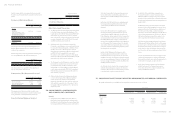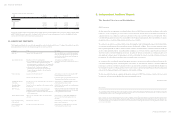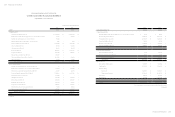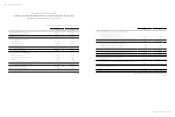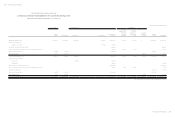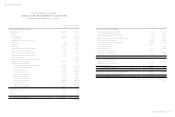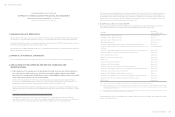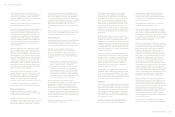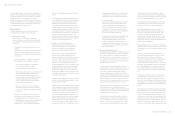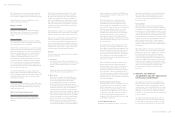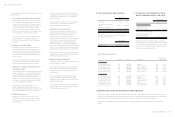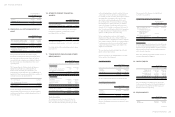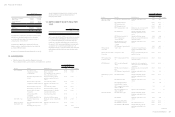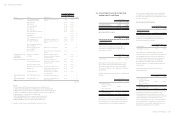HTC 2015 Annual Report Download - page 126
Download and view the complete annual report
Please find page 126 of the 2015 HTC annual report below. You can navigate through the pages in the report by either clicking on the pages listed below, or by using the keyword search tool below to find specific information within the annual report.
Financial information
Financial information
248
249
and contingent liabilities of an associate and a joint venture
recognized at the date of acquisition is recognized as
goodwill, which is included within the carrying amount of the
investment and is not amortized. Any excess of the Company's
share of the net fair value of the identifiable assets, liabilities
and contingent liabilities over the cost of acquisition, after
reassessment, is recognized immediately in profit or loss.
The entire carrying amount of the investment (including
goodwill) is tested for impairment as a single asset by
comparing its recoverable amount with its carrying amount.
Any impairment loss recognized forms part of the carrying
amount of the investment. Any reversal of that impairment
loss is recognized to the extent that the recoverable amount of
the investment subsequently increases.
The Company discontinues the use of the equity method from
the date on which its investment ceases to be an associate and
the joint venture. Any retained investment is measured at
fair value at that date and the fair value is regarded as its fair
value on initial recognition as a financial asset. The difference
between the previous carrying amount of the associate and
the joint venture attributable to the retained interest and
its fair value is included in the determination of the gain or
loss on disposal of the associate and the joint venture. The
Company accounts for all amounts previously recognized
in other comprehensive income in relation to that associate
and the joint venture on the same basis as would be required
if that associate had directly disposed of the related assets or
liabilities.
When a group entity transacts with its associate and joint
venture, profits and losses resulting from the transactions
with the associate and joint venture are recognized in the
Company' consolidated financial statements only to the extent
of interests in the associate and the joint venture that are not
related to the Company.
Property, Plant and Equipment
Property, plant and equipment are stated at cost, less
subsequent accumulated depreciation and subsequent
accumulated impairment loss.
Properties, plant and equipment in the course of construction
are carried at cost, less any recognized impairment loss. Cost
includes professional fees and borrowing costs eligible for
capitalization. Such properties are depreciated and classified
to the appropriate categories of property, plant and equipment
when completed and ready for intended use.
Depreciation on property, plant and equipment is recognized
using the straight-line method. Each significant part is
the entity disposes of an operation within that unit, the
goodwill associated with the operation disposed of is included
in the carrying amount of the operation when determining the
gain or loss on disposal, and is measured on the basis of the
relative values of the operation disposed of and the portion of
the cash-generating unit retained.
Intangible Assets
Intangible assets acquired separately
Intangible assets with finite useful lives that are acquired
separately are initially measured at cost and subsequently
measured at cost less accumulated amortization and
accumulated impairment loss. Amortization is recognized on
a straight-line basis. The estimated useful life, residual value,
and amortization method are reviewed at the end of each
reporting period, with the effect of any changes in estimate
accounted for on a prospective basis. The residual value of an
intangible asset with a finite useful life shall be assumed to be
zero unless the Company expects to dispose of the intangible
asset before the end of its economic life. Intangible assets
with indefinite useful lives that are acquired separately are
measured at cost less accumulated impairment loss.
Intangible assets acquired in a business combination
Intangible assets acquired in a business combination and
recognized separately from goodwill are initially recognized
at their fair value at the acquisition date (which is regarded
as their cost). Subsequent to initial recognition, intangible
assets acquired in a business combination are reported at cost
less accumulated amortization and accumulated impairment
losses, on the same basis as intangible assets that are acquired
separately.
Derecognition of intangible assets
Gains or losses arising from derecognition of an intangible
asset, measured as the difference between the net disposal
proceeds and the carrying amount of the asset, are recognized
in profit or loss when the asset is derecognized.
Impairment of Tangible and Intangible Assets
Other Than Goodwill
At the end of each reporting period, the Company reviews
the carrying amounts of its tangible and intangible assets,
excluding goodwill, to determine whether there is any
indication that those assets have suffered an impairment
loss. If any such indication exists, the recoverable amount of
the asset is estimated in order to determine the extent of the
impairment loss, if any. When it is not possible to estimate
the recoverable amount of an individual asset, the Company
estimates the recoverable amount of the cash-generating unit
depreciated separately. The estimated useful lives, residual
values and depreciation method are reviewed at the end
of each reporting period, with the effect of any changes in
estimate accounted for on a prospective basis.
On derecognition of an item of property, plant and equipment,
the difference between the sales proceeds and the carrying
amount of the asset is recognized in profit or loss.
Investment Properties
Investment properties are properties held to earn rentals
and/or for capital appreciation. Investment properties also
include land held for a currently undetermined future use.
Investment properties are measured initially at cost,
including transaction costs. Subsequent to initial recognition,
investment properties are measured at cost less accumulated
depreciation and accumulated impairment loss. Depreciation
is recognized using the straight-line method.
On derecognition of an investment property, the difference
between the net disposal proceeds and the carrying amount of
the asset is included in profit or loss.
Goodwill
Goodwill arising on an acquisition of a business is carried at
cost as established at the date of acquisition of the business
less accumulated impairment losses, if any.
For the purposes of impairment testing, goodwill is allocated
to each of the Company's cash-generating units (or groups
of cash-generating units) that is expected to benefit from the
synergies of the combination.
A cash-generating unit to which goodwill has been allocated is
tested for impairment annually, or more frequently when there
is an indication that the unit may be impaired, by comparing
its carrying amount, including the attributable goodwill, with
its recoverable amount. However, if the goodwill allocated to a
cash-generating unit was acquired in a business combination
during the current annual period, that unit shall be tested for
impairment before the end of the current annual period. If
the recoverable amount of the cash-generating unit is less
than its carrying amount, the impairment loss is allocated first
to reduce the carrying amount of any goodwill allocated to the
unit and then to the other assets of the unit pro rata based on
the carrying amount of each asset in the unit. Any impairment
loss is recognized directly in profit or loss. An impairment loss
recognized for goodwill is not reversed in subsequent periods.
If goodwill has been allocated to a cash-generating unit and
to which the asset belongs. When a reasonable and consistent
basis of allocation can be identified, corporate assets are also
allocated to individual cash-generating units, or otherwise
they are allocated to the smallest group of cash-generating
units for which a reasonable and consistent allocation basis.
Intangible assets with indefinite useful lives and intangible
assets not yet available for use are tested for impairment at
least annually, and whenever there is an indication that the
asset may be impaired.
Recoverable amount is the higher of fair value less costs to
sell and value in use. If the recoverable amount of an asset or
cash-generating unit is estimated to be less than its carrying
amount, the carrying amount of the asset or cash-generating
unit is reduced to its recoverable amount, with the resulting
impairment loss recognized in profit or loss.
When an impairment loss subsequently is reversed, the
carrying amount of the asset or a cash-generating unit is
increased to the revised estimate of its recoverable amount,
but so that the increased carrying amount does not exceed
the carrying amount that would have been determined had
no impairment loss been recognized for the asset (or cash-
generating unit) in prior years. A reversal of an impairment
loss is recognized immediately in profit or loss.
Non-current Assets Held for Sale
Non-current assets are classified as held for sale if their
carrying amount will be recovered principally through a
sale transaction rather than through continuing use. This
condition is regarded as met only when the sale is highly
probable and the non-current asset is available for immediate
sale in its present condition. To meet the criteria for the sale
being highly probable, the appropriate level of management
must be committed to the sale, which should be expected to
qualify for recognition as a completed sale within one year
from the date of classification.
Non-current assets classified as held for sale are measured at
the lower of their previous carrying amount and fair value less
costs to sell. Recognition of depreciation of those assets would
cease.
Financial Instruments
Financial assets and financial liabilities are recognized when a
group entity becomes a party to the contractual provisions of
the instruments.
Financial assets and financial liabilities are initially measured
at fair value. Transaction costs that are directly attributable



